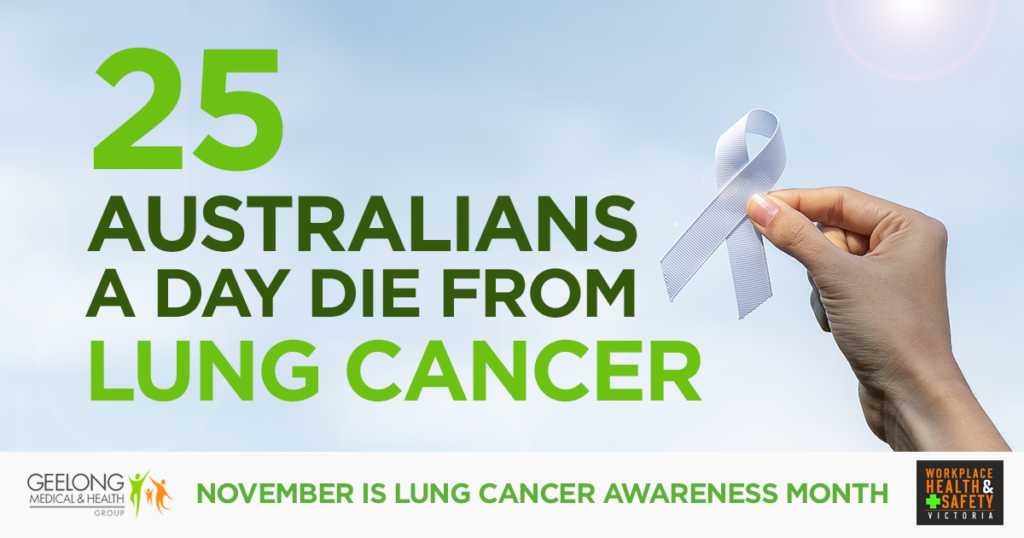Shine a Light On Lung Cancer
November 1 2021November is Lung Cancer Awareness Month.

Lung Cancer is Australia’s #1 cancer killer. Let’s shine a light to this deadly disease and support the research into the development of treatments, diagnosis pathways and one day, a cure to give hope to the 13,250 Australians diagnosed every year.
What is Lung Cancer?
Lung cancer is a malignant tumour in the tissue of one or both lungs. A tumour may be found in the bronchi or in the spongy lung tissue. A tumour that starts in the lung is known as a primary lung cancer. Tumours in the lung may also be due to cancer which has spread through the blood from another part of the body such as the breast, bowel, or prostate – these cancers are called lung “secondary” or “metastases”. The following information refers to primary lung cancer.
Like other cancers, lung cancer is the result of the uncontrolled growth and multiplication of cells in the lung(s). Over time, this abnormal cell growth develops into a progressively larger mass which starts to invade functional parts of the lung, affecting breathing, causing pain and symptoms related to the loss of normal lung function. Doctors call this abnormal cluster of cells a “tumour”. These abnormal cells grow and divide uncontrollably and, if left untreated, eventually spread throughout the body.
Causes
The cause of lung cancer, and other cancers, is not fully understood. However, it is thought that changes in the genes that program cell functions become faulty. This results in abnormal cell growth and/or multiplication. For many types of cancers, including lung cancer, external influences, such as lifestyle, diet, chemicals and environment, may trigger these faulty genes into action.
Tobacco smoking has been scientifically identified as a cause of lung cancer. However, people who have never smoked can also be diagnosed with the disease. The risk of developing lung cancer decreases in people who stop smoking, but they are still at higher risk than people who have never smoked.
Other risk factors have also been identified as having a link to the development of lung cancer.
- Smoking and exposure to second-hand smoke
- Occupational exposure such as asbestos, dust and chemicals
- Pollution such as chemical, radiation and radon exposure
- Genetics – a family history of lung cancer increases the risk for the disease in both smokers and never-smokers.
Symptoms
Diagnosis & Types
Currently, there is no recognised early screening program for lung cancer . It is therefore important to discuss any symptoms or concerns with your doctor. Make sure you discuss all your symptoms with your doctor so that they can work with you to choose the best tests to confirm your diagnosis early and help to develop a treatment plan.
There are many different types of diagnostic imaging and pathology tests used to accurately diagnose and stage lung cancer. The purpose of these tests is to identify the type of lung cancer you have and to identify the size or stage of your cancer. You may be required to visit a variety of different healthcare centres to get all the diagnostic tests completed. You may see multiple doctors and health professionals during this diagnostic stage. This team of health professionals is called a multidisciplinary team and they work together to determine which tests are relevant to you.
Treatment
Once lung cancer has been diagnosed and staging has been made, the doctor can then determine which treatment(s) may be best suited. There is a wide range of treatments for lung cancer including surgery, radiotherapy, chemotherapy, immunotherapy and targeted therapy.
Support
When someone is first diagnosed with lung cancer and throughout the different phases of treatment and recovery, it is normal to experience a range of emotions such as fear, sadness, anxiety, anger and frustration. It is helpful to keep communication lines open with family, carers and healthcare team and discuss how they are feeling. If feelings of sadness or anxiety are ongoing or severe, talk to anyone in the healthcare team. Lung Foundation Australia offers a range of services and resources to support and help improve a patient’s well-being.
For more information, visit the Lung Cancer Foundation
—
Article originally from the Lung Cancer Foundation.
